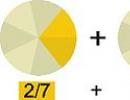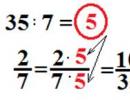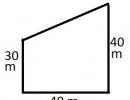Converting a fraction to a common denominator. Adding and subtracting ordinary fractions. Reducing fractions to the same denominator. The concept of NOC. Download video lesson “Reducing fractions to a common denominator”
In this lesson we will look at reducing fractions to a common denominator and solve problems on this topic. Let's define the concept of a common denominator and an additional factor, and remember about relatively prime numbers. Let's define the concept of the lowest common denominator (LCD) and solve a number of problems to find it.
Topic: Adding and subtracting fractions with different denominators
Lesson: Reducing fractions to a common denominator
Repetition. The main property of a fraction.
If the numerator and denominator of a fraction are multiplied or divided by the same natural number, you get an equal fraction.
For example, the numerator and denominator of a fraction can be divided by 2. We get the fraction. This operation is called fraction reduction. You can also perform the inverse transformation by multiplying the numerator and denominator of the fraction by 2. In this case, we say that we have reduced the fraction to a new denominator. The number 2 is called an additional factor.
Conclusion. A fraction can be reduced to any denominator that is a multiple of the denominator of the given fraction. To bring a fraction to a new denominator, its numerator and denominator are multiplied by an additional factor.
1. Reduce the fraction to the denominator 35.

The number 35 is a multiple of 7, that is, 35 is divisible by 7 without a remainder. This means that this transformation is possible. Let's find an additional factor. To do this, divide 35 by 7. We get 5. Multiply the numerator and denominator of the original fraction by 5.
2. Reduce the fraction to denominator 18.

Let's find an additional factor. To do this, divide the new denominator by the original one. We get 3. Multiply the numerator and denominator of this fraction by 3.
3. Reduce the fraction to a denominator of 60.

Dividing 60 by 15 gives an additional factor. It is equal to 4. Multiply the numerator and denominator by 4.
4. Reduce the fraction to the denominator 24

In simple cases, reduction to a new denominator is performed mentally. It is only customary to indicate the additional factor behind a bracket slightly to the right and above the original fraction.

A fraction can be reduced to a denominator of 15 and a fraction can be reduced to a denominator of 15. Fractions also have a common denominator of 15.
The common denominator of fractions can be any common multiple of their denominators. For simplicity, fractions are reduced to their lowest common denominator. It is equal to the least common multiple of the denominators of the given fractions.
Example. Reduce the fractions and to the lowest common denominator.

First, let's find the least common multiple of the denominators of these fractions. This number is 12. Let's find an additional factor for the first and second fractions. To do this, divide 12 by 4 and 6. Three is an additional factor for the first fraction, and two is for the second. Let's bring the fractions to the denominator 12.
We brought the fractions to a common denominator, that is, we found equal fractions that have the same denominator.
Rule. To reduce fractions to their lowest common denominator, you must
First, find the least common multiple of the denominators of these fractions, it will be their least common denominator;
Secondly, divide the lowest common denominator by the denominators of these fractions, i.e. find an additional factor for each fraction.
Third, multiply the numerator and denominator of each fraction by its additional factor.
a) Reduce the fractions and to a common denominator.

The lowest common denominator is 12. The additional factor for the first fraction is 4, for the second - 3. We reduce the fractions to the denominator 24.
b) Reduce the fractions and to a common denominator.

The lowest common denominator is 45. Dividing 45 by 9 by 15 gives 5 and 3, respectively. We reduce the fractions to the denominator 45.
c) Reduce the fractions and to a common denominator.

The common denominator is 24. Additional factors are 2 and 3, respectively.
Sometimes it can be difficult to verbally find the least common multiple of the denominators of given fractions. Then the common denominator and additional factors are found using prime factorization.
Reduce the fractions and to a common denominator.

Let's factor the numbers 60 and 168 into prime factors. Let's write out the expansion of the number 60 and add the missing factors 2 and 7 from the second expansion. Let's multiply 60 by 14 and get a common denominator of 840. The additional factor for the first fraction is 14. The additional factor for the second fraction is 5. Let's bring the fractions to a common denominator of 840.
Bibliography
1. Vilenkin N.Ya., Zhokhov V.I., Chesnokov A.S. and others. Mathematics 6. - M.: Mnemosyne, 2012.
2. Merzlyak A.G., Polonsky V.V., Yakir M.S. Mathematics 6th grade. - Gymnasium, 2006.
3. Depman I.Ya., Vilenkin N.Ya. Behind the pages of a mathematics textbook. - Enlightenment, 1989.
4. Rurukin A.N., Tchaikovsky I.V. Assignments for the mathematics course for grades 5-6. - ZSh MEPhI, 2011.
5. Rurukin A.N., Sochilov S.V., Tchaikovsky K.G. Mathematics 5-6. A manual for 6th grade students at the MEPhI correspondence school. - ZSh MEPhI, 2011.
6. Shevrin L.N., Gein A.G., Koryakov I.O. and others. Mathematics: Textbook-interlocutor for 5-6 grades of secondary school. Math teacher's library. - Enlightenment, 1989.
You can download the books specified in clause 1.2. of this lesson.
Homework
Vilenkin N.Ya., Zhokhov V.I., Chesnokov A.S. and others. Mathematics 6. - M.: Mnemosyne, 2012. (link see 1.2)
Homework: No. 297, No. 298, No. 300.
Other tasks: No. 270, No. 290
This article explains how to find the lowest common denominator And how to reduce fractions to a common denominator. First, the definitions of common denominator of fractions and least common denominator are given, and it is shown how to find the common denominator of fractions. Below is a rule for reducing fractions to a common denominator and examples of the application of this rule are considered. In conclusion, examples of bringing three or more fractions to a common denominator are discussed.
Page navigation.
What is called reducing fractions to a common denominator?
Now we can say what it is to reduce fractions to a common denominator. Reducing fractions to a common denominator- This is the multiplication of the numerators and denominators of given fractions by such additional factors that the result is fractions with the same denominators.
Common denominator, definition, examples
Now it's time to define the common denominator of fractions.
In other words, the common denominator of a certain set of ordinary fractions is any natural number that is divisible by all the denominators of these fractions.
From the stated definition it follows that a given set of fractions has infinitely many common denominators, since there is an infinite number of common multiples of all denominators of the original set of fractions.
Determining the common denominator of fractions allows you to find the common denominators of given fractions. Let, for example, given the fractions 1/4 and 5/6, their denominators are 4 and 6, respectively. Positive common multiples of the numbers 4 and 6 are the numbers 12, 24, 36, 48, ... Any of these numbers is a common denominator of the fractions 1/4 and 5/6.
To consolidate the material, consider the solution to the following example.
Example.
Can the fractions 2/3, 23/6 and 7/12 be reduced to a common denominator of 150?
Solution.
To answer the question we need to find out whether the number 150 is a common multiple of the denominators 3, 6 and 12. To do this, let’s check whether 150 is divisible by each of these numbers (if necessary, see the rules and examples of dividing natural numbers, as well as the rules and examples of dividing natural numbers with a remainder): 150:3=50, 150:6=25, 150: 12=12 (remaining 6) .
So, 150 is not evenly divisible by 12, therefore 150 is not a common multiple of 3, 6, and 12. Therefore, the number 150 cannot be the common denominator of the original fractions.
Answer:
It is forbidden.
Lowest common denominator, how to find it?
In the set of numbers that are common denominators of given fractions, there is a smallest natural number, which is called the least common denominator. Let us formulate the definition of the lowest common denominator of these fractions.
Definition.
Lowest common denominator is the smallest number of all the common denominators of these fractions.
It remains to deal with the question of how to find the least common divisor.
Since is the least positive common divisor of a given set of numbers, the LCM of the denominators of the given fractions represents the least common denominator of the given fractions.
Thus, finding the lowest common denominator of fractions comes down to the denominators of those fractions. Let's look at the solution to the example.
Example.
Find the lowest common denominator of the fractions 3/10 and 277/28.
Solution.
The denominators of these fractions are 10 and 28. The desired lowest common denominator is found as the LCM of the numbers 10 and 28. In our case it’s easy: since 10=2·5, and 28=2·2·7, then LCM(15, 28)=2·2·5·7=140.
Answer:
140 .
How to reduce fractions to a common denominator? Rule, examples, solutions
Common fractions usually result in a lowest common denominator. We will now write down a rule that explains how to reduce fractions to their lowest common denominator.
Rule for reducing fractions to lowest common denominator consists of three steps:
- First, find the lowest common denominator of the fractions.
- Second, an additional factor is calculated for each fraction by dividing the lowest common denominator by the denominator of each fraction.
- Third, the numerator and denominator of each fraction are multiplied by its additional factor.
Let us apply the stated rule to solve the following example.
Example.
Reduce the fractions 5/14 and 7/18 to their lowest common denominator.
Solution.
Let's perform all the steps of the algorithm for reducing fractions to the lowest common denominator.
First we find the least common denominator, which is equal to the least common multiple of the numbers 14 and 18. Since 14=2·7 and 18=2·3·3, then LCM(14, 18)=2·3·3·7=126.
Now we calculate additional factors with the help of which the fractions 5/14 and 7/18 will be reduced to the denominator 126. For the fraction 5/14 the additional factor is 126:14=9, and for the fraction 7/18 the additional factor is 126:18=7.
It remains to multiply the numerators and denominators of the fractions 5/14 and 7/18 by additional factors 9 and 7, respectively. We have and  .
.
So, reducing the fractions 5/14 and 7/18 to the lowest common denominator is complete. The resulting fractions were 45/126 and 49/126.
In this lesson we will look at reducing fractions to a common denominator and solve problems on this topic. Let's define the concept of a common denominator and an additional factor, and remember about relatively prime numbers. Let's define the concept of the lowest common denominator (LCD) and solve a number of problems to find it.
Topic: Adding and subtracting fractions with different denominators
Lesson: Reducing fractions to a common denominator
Repetition. The main property of a fraction.
If the numerator and denominator of a fraction are multiplied or divided by the same natural number, you get an equal fraction.
For example, the numerator and denominator of a fraction can be divided by 2. We get the fraction. This operation is called fraction reduction. You can also perform the inverse transformation by multiplying the numerator and denominator of the fraction by 2. In this case, we say that we have reduced the fraction to a new denominator. The number 2 is called an additional factor.
Conclusion. A fraction can be reduced to any denominator that is a multiple of the denominator of the given fraction. To bring a fraction to a new denominator, its numerator and denominator are multiplied by an additional factor.
1. Reduce the fraction to the denominator 35.

The number 35 is a multiple of 7, that is, 35 is divisible by 7 without a remainder. This means that this transformation is possible. Let's find an additional factor. To do this, divide 35 by 7. We get 5. Multiply the numerator and denominator of the original fraction by 5.
2. Reduce the fraction to denominator 18.

Let's find an additional factor. To do this, divide the new denominator by the original one. We get 3. Multiply the numerator and denominator of this fraction by 3.
3. Reduce the fraction to a denominator of 60.

Dividing 60 by 15 gives an additional factor. It is equal to 4. Multiply the numerator and denominator by 4.
4. Reduce the fraction to the denominator 24

In simple cases, reduction to a new denominator is performed mentally. It is only customary to indicate the additional factor behind a bracket slightly to the right and above the original fraction.

A fraction can be reduced to a denominator of 15 and a fraction can be reduced to a denominator of 15. Fractions also have a common denominator of 15.
The common denominator of fractions can be any common multiple of their denominators. For simplicity, fractions are reduced to their lowest common denominator. It is equal to the least common multiple of the denominators of the given fractions.
Example. Reduce the fractions and to the lowest common denominator.

First, let's find the least common multiple of the denominators of these fractions. This number is 12. Let's find an additional factor for the first and second fractions. To do this, divide 12 by 4 and 6. Three is an additional factor for the first fraction, and two is for the second. Let's bring the fractions to the denominator 12.
We brought the fractions to a common denominator, that is, we found equal fractions that have the same denominator.
Rule. To reduce fractions to their lowest common denominator, you must
First, find the least common multiple of the denominators of these fractions, it will be their least common denominator;
Secondly, divide the lowest common denominator by the denominators of these fractions, i.e. find an additional factor for each fraction.
Third, multiply the numerator and denominator of each fraction by its additional factor.
a) Reduce the fractions and to a common denominator.

The lowest common denominator is 12. The additional factor for the first fraction is 4, for the second - 3. We reduce the fractions to the denominator 24.
b) Reduce the fractions and to a common denominator.

The lowest common denominator is 45. Dividing 45 by 9 by 15 gives 5 and 3, respectively. We reduce the fractions to the denominator 45.
c) Reduce the fractions and to a common denominator.

The common denominator is 24. Additional factors are 2 and 3, respectively.
Sometimes it can be difficult to verbally find the least common multiple of the denominators of given fractions. Then the common denominator and additional factors are found using prime factorization.
Reduce the fractions and to a common denominator.

Let's factor the numbers 60 and 168 into prime factors. Let's write out the expansion of the number 60 and add the missing factors 2 and 7 from the second expansion. Let's multiply 60 by 14 and get a common denominator of 840. The additional factor for the first fraction is 14. The additional factor for the second fraction is 5. Let's bring the fractions to a common denominator of 840.
Bibliography
1. Vilenkin N.Ya., Zhokhov V.I., Chesnokov A.S. and others. Mathematics 6. - M.: Mnemosyne, 2012.
2. Merzlyak A.G., Polonsky V.V., Yakir M.S. Mathematics 6th grade. - Gymnasium, 2006.
3. Depman I.Ya., Vilenkin N.Ya. Behind the pages of a mathematics textbook. - Enlightenment, 1989.
4. Rurukin A.N., Tchaikovsky I.V. Assignments for the mathematics course for grades 5-6. - ZSh MEPhI, 2011.
5. Rurukin A.N., Sochilov S.V., Tchaikovsky K.G. Mathematics 5-6. A manual for 6th grade students at the MEPhI correspondence school. - ZSh MEPhI, 2011.
6. Shevrin L.N., Gein A.G., Koryakov I.O. and others. Mathematics: Textbook-interlocutor for 5-6 grades of secondary school. Math teacher's library. - Enlightenment, 1989.
You can download the books specified in clause 1.2. of this lesson.
Homework
Vilenkin N.Ya., Zhokhov V.I., Chesnokov A.S. and others. Mathematics 6. - M.: Mnemosyne, 2012. (link see 1.2)
Homework: No. 297, No. 298, No. 300.
Other tasks: No. 270, No. 290
To reduce fractions to the least common denominator, you need to: 1) find the least common multiple of the denominators of the given fractions, it will be the least common denominator. 2) find an additional factor for each fraction by dividing the new denominator by the denominator of each fraction. 3) multiply the numerator and denominator of each fraction by its additional factor.
Examples. Reduce the following fractions to their lowest common denominator.

We find the least common multiple of the denominators: LCM(5; 4) = 20, since 20 is the smallest number that is divisible by both 5 and 4. Find for the 1st fraction an additional factor 4 (20 : 5=4). For the 2nd fraction the additional factor is 5 (20 : 4=5). We multiply the numerator and denominator of the 1st fraction by 4, and the numerator and denominator of the 2nd fraction by 5. We have reduced these fractions to the lowest common denominator ( 20 ).

The lowest common denominator of these fractions is the number 8, since 8 is divisible by 4 and itself. There will be no additional factor for the 1st fraction (or we can say that it is equal to one), for the 2nd fraction the additional factor is 2 (8 : 4=2). We multiply the numerator and denominator of the 2nd fraction by 2. We have reduced these fractions to the lowest common denominator ( 8 ).

These fractions are not irreducible.
Let's reduce the 1st fraction by 4, and reduce the 2nd fraction by 2. ( see examples on reducing ordinary fractions: Sitemap → 5.4.2. Examples of reducing common fractions). Find the LOC(16 ; 20)=2 4 · 5=16· 5=80. The additional multiplier for the 1st fraction is 5 (80 : 16=5). The additional factor for the 2nd fraction is 4 (80 : 20=4). We multiply the numerator and denominator of the 1st fraction by 5, and the numerator and denominator of the 2nd fraction by 4. We have reduced these fractions to the lowest common denominator ( 80 ).

We find the lowest common denominator NCD(5 ; 6 and 15)=NOK(5 ; 6 and 15)=30. The additional factor to the 1st fraction is 6 (30 : 5=6), the additional factor to the 2nd fraction is 5 (30 : 6=5), the additional factor to the 3rd fraction is 2 (30 : 15=2). We multiply the numerator and denominator of the 1st fraction by 6, the numerator and denominator of the 2nd fraction by 5, the numerator and denominator of the 3rd fraction by 2. We have reduced these fractions to the lowest common denominator ( 30 ).
Page 1 of 1 1






